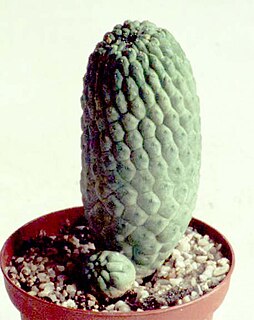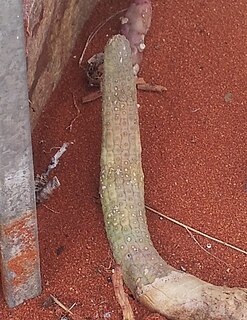| Rhytidocaulon | |
|---|---|
 | |
| Rhytidocaulon macrolobum | |
| Scientific classification | |
| Kingdom: | |
| (unranked): | |
| (unranked): | |
| (unranked): | |
| Order: | |
| Family: | |
| Subfamily: | |
| Genus: | Rhytidocaulon P.R.O.Bally |
Rhytidocaulon is a plant genus in the family Apocynaceae, first described in 1962. [1] [2] It is native to northeastern Africa and the Arabian Peninsula

Apocynaceae is a family of flowering plants that includes trees, shrubs, herbs, stem succulents, and vines, commonly known as the dogbane family,. Members of the family are native to the European, Asian, African, Australian, and American tropics or subtropics, with some temperate members. The former family Asclepiadaceae is considered a subfamily of Apocynaceae and contains 348 genera. A list of Apocynaceae genera may be found here.

Africa is the world's second largest and second most-populous continent, being behind Asia in both categories. At about 30.3 million km2 including adjacent islands, it covers 6% of Earth's total surface area and 20% of its land area. With 1.2 billion people as of 2016, it accounts for about 16% of the world's human population. The continent is surrounded by the Mediterranean Sea to the north, the Isthmus of Suez and the Red Sea to the northeast, the Indian Ocean to the southeast and the Atlantic Ocean to the west. The continent includes Madagascar and various archipelagos. It contains 54 fully recognised sovereign states (countries), nine territories and two de facto independent states with limited or no recognition. The majority of the continent and its countries are in the Northern Hemisphere, with a substantial portion and number of countries in the Southern Hemisphere.

The Arabian peninsula, simplified Arabia, is a peninsula of Western Asia situated northeast of Africa on the Arabian plate. From a geographical perspective, it is considered a subcontinent of Asia.
- Species [3]
- Rhytidocaulon paradoxum P.R.O.Bally - Ethiopia
- Rhytidocaulon piliferum Lavranos - Somalia
- Rhytidocaulon richardianum Lavranos - Somalia
- Rhytidocaulon subscandens P.R.O.Bally - Somalia, Ethiopia
- Rhytidocaulon tortum (N.E.Br.) M.G.Gilbert - Arabia
- species with undetermined affinities [3]
- Taxonomy
Phylogenetic studies have shown the genus to be monophyletic, and most closely related to the genus Echidnopsis which inhabits the same region. Marginally more distantly related is a sister branch comprising the genus Pseudolithos and the widespread Caralluma stapeliads of North Africa. [4]

Echidnopsis is a genus of succulent, cactus-like plants in the Apocynaceae, first described as a genus in 1871. They are native to eastern Africa and the Arabian Peninsula.

Pseudolithos is a genus of succulent flowering plants of the family Apocynaceae, indigenous to Somalia, Yemen and Oman.

Caralluma is a genus of flowering plants in the dogbane family, Apocynaceae, consisting of about 120 species. The generic name is derived from the Arabic word qahr al-luhum, meaning "wound in the flesh" or "abscess," referring to the floral odour. Most of the species occur in Africa, including several taxa valued by people for their medicinal properties.














